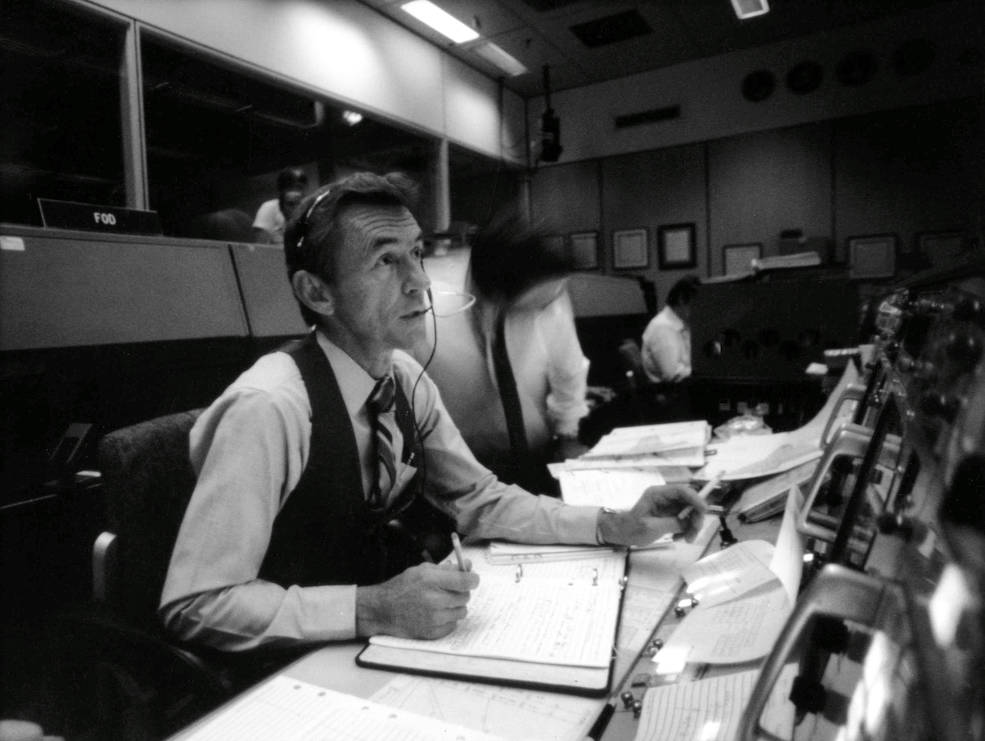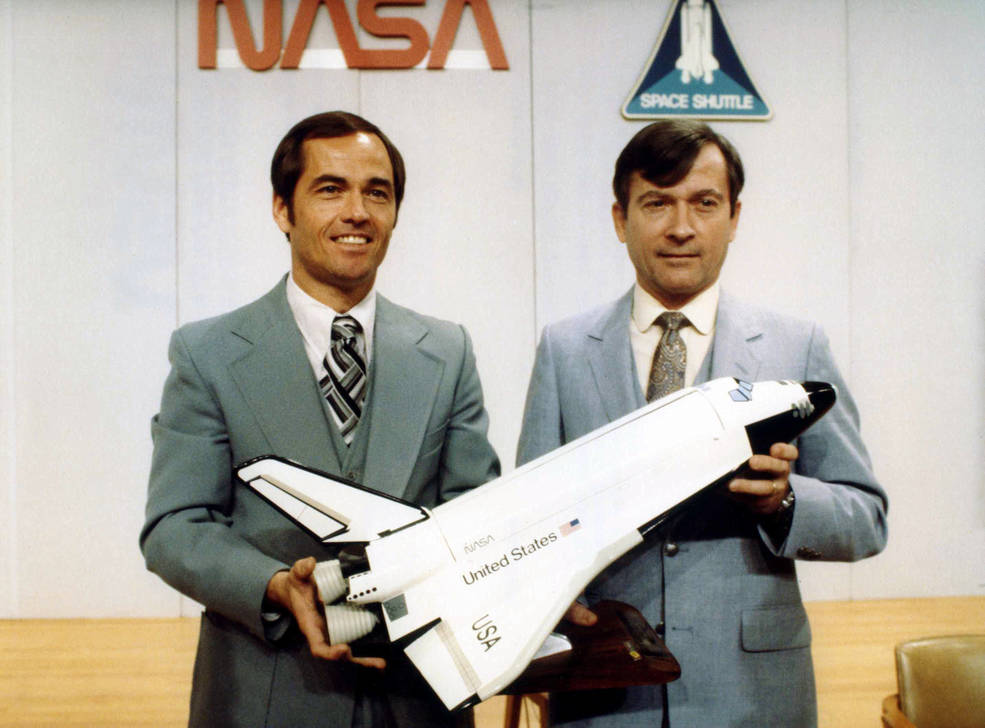The new year of 1981 opened with optimism regarding the first launch of the Space Shuttle Program. Workers had rolled space shuttle Columbia to its seaside launch pad on Dec. 29, 1980, where engineers began testing the entire system to prepare the vehicle for STS-1, the first mission of the program. NASA astronauts John W. Young and Robert L. Crippen, the prime crew for STS-1, held a press conference to describe their mission to assembled reporters. They participated in a full-mission duration simulation with the teams of controllers at the Mission Control Center. The space shuttle’s main engines passed their final critical test, and engineers filled and emptied the external tank with cryogenic propellants, clearing the way for the Flight Readiness Firing (FRF) in February.



Left: Flight Director Neil B. Hutchinson during an STS-1 simulation.
Middle: Flight Director Charles R. “Chuck” Lewis during a simulation for STS-1.
Right: Flight Director Donald R. Puddy during an STS-1 simulation.
Flight controllers in the Mission Control Center at NASA’s Johnson Space Center (JSC) in Houston completed the sixth and second to last full-duration 54-hour simulation of the STS-1 mission Jan. 20-22. Under the leadership of flight directors Neil B. Hutchinson, Charles R. “Chuck” Lewis, and Donald R. Puddy, three teams of controllers followed the STS-1 flight plan, with simulated anomalies introduced by the simulation team. Young and Crippen participated from the fixed-base Shuttle Mission Simulator at JSC and responded successfully to all the anomalies presented to them.


Left: Prime crew for STS-1 John W. Young, left, and Robert L. Crippen, in a lighthearted
moment during a preflight press conference at NASA’s Johnson Space Center in Houston.
Right: Crippen, left, and Young pose for photographers with a model of space shuttle
Columbia following the press conference.
Young and Crippen held a press conference with reporters at JSC on Jan. 23. The two outlined the plans for their 54-hour mission and their remaining activities until the launch, including one more full-mission duration simulation following the FRF and participation in the terminal countdown demonstration test about two weeks before launch.


Left: The space shuttle Main Propulsion Test Assembly during a
three-engine test firing at NASA’s National Space Test Laboratories in
Bay St. Louis, Mississippi. Right: Space shuttle Columbia on Launch Pad 39A.
The Space Shuttle Main Engines (SSMEs) passed their final critical test on Jan. 17 at NASA’s National Space Testing Laboratories in Bay St. Louis, Mississippi. During this 12th static firing using the Main Propulsion Test Article (MPTA), consisting of three flight-like SSMEs, an aft space shuttle fuselage, and a full-size external tank, all three engines ignited as planned. As per the plan, engine number 3 shut down after 235 seconds, and the remaining two engines continued firing until 624.5 seconds, completing the longest firing in the test program. All major objectives were met, including gimbaling of the engines and completing a full duration run using flight nozzles. Completing this test cleared the engines for the FRF in mid-February at NASA’s Kennedy Space Center’s Launch Pad 39A of the three engines installed on Columbia, a key milestone before the orbiter’s first launch. Other work at the pad included a series of pad validation tests, completed on Jan. 5, to verify all the interfaces between the launch pad and the vehicle. A weeklong so-called “plugs-out” test began on Jan. 10, and included a mock countdown to verify orbiter and ground systems. Backup STS-1 crew members Joe H. Engle and Richard H. Truly participated in the latter stages of the tests, seated in Columbia’s cockpit. Between Jan. 22-24, engineers successfully completed another milestone by filling and emptying the large external tank with cryogenic propellants – 384,000 gallons of liquid hydrogen and 140,000 gallons of liquid oxygen. A readiness review on Jan. 30 set Feb. 17 as the date for the FRF, with an estimated launch date on April 5.



Left: NASA Acting Administrator Alan M. Lovelace.
Middle: Outgoing NASA Administrator Robert A. Frosch.
Right: Incoming NASA Administrator James M. Beggs.
During the presidential transition, outgoing President James E. “Jimmy” Carter and incoming President Ronald W. Reagan agreed to name NASA Deputy Administrator Alan M. Lovelace as the agency’s acting administrator, effective Jan. 20, 1981, the day of President Reagan’s inauguration. In October 1980, Administrator Robert A. Frosch informed President Carter that he was resigning from the agency effective Jan. 20, 1981. Lovelace served as acting administrator until the Senate confirmed President Reagan’s choice for administrator, James M. Beggs, on July 10, 1981.
To be continued…
Significant world events in January 1981:
January 11 – British team completes the longest and fastest crossing of Antarctica, 2,500 miles in 75 days
January 12 – “Dynasty” premieres on ABC
January 15 – “Hill Street Blues” premieres on NBC
January 19 – The United States and Iran sign an agreement for the release of 52 American hostages
January 20 – Ronald W. Reagan inaugurated as the 40th President of the United States
January 25 – Oakland Raiders beat Philadelphia Eagles 27-10 in Super Bowl XV
January 31 – “The Tide is High” by Blondie hits No. 1




























